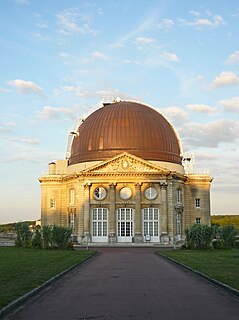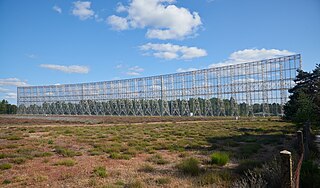 W
WThe Paris Observatory, a research institution of the Paris Sciences et Lettres University, is the foremost astronomical observatory of France, and one of the largest astronomical centres in the world. Its historic building is on the Left Bank of the Seine in central Paris, but most of the staff work on a satellite campus in Meudon, a suburb southwest of Paris.
 W
WArago telescope is a 38 cm aperture refracting telescope at Paris Observatory, installed in 1857. Francois Arago ordered this telescope from the telescope making firm Lebreours in 1839, and after a protracted development was completed by 1855. The name Lunette Arago is a modern name for the telescope, and other large refractor of Paris observatory, is the one at Meudon. It has gone by a variety of names having to do with various aspects of the telescope, such as its aperture, or location on the East tower of the Paris observatory, or its equatorial mount made by Brunner. In one journal report it was called the 'east equatorial' for example, in another instance '38 cm refractor'. In French language it has been called the La lunette équatoriale de 38 cm de l'Observatoire de Paris.
 W
WThe Connaissance des temps is an official yearly publication of astronomical ephemerides in France. Until just after the French Revolution, the title appeared as Connoissance des temps, and for several years afterwards also as Connaissance des tems.
 W
WMeudon Great Refractor is a double telescope with lenses, in Meudon, France. It is a twin refracting telescope built in 1891, with one visual and one photographic, on a single square-tube together on an equatorial mount, inside a dome. The Refractor was built for the Meudon Observatory, and is the largest double doublet refracting telescope in Europe, but about the same size as several telescopes in this period, when this style of telescope was popular. Other large telescopes of a similar type include the James Lick telescope (91.4), Potsdam Great Refractor (80+50 cm), and the Greenwich 28 inch refractor (71.1 cm).
 W
WThe Nançay Radio Observatory, opened in 1956, is part of Paris Observatory, and also associated with the University of Orléans. It is located in the department of Cher in the Sologne region of France. The station consists of several instruments. Most iconic of these is the large decimetric radio telescope, which is one of the largest radio telescopes in the world. Long established are also the radio heliograph, a T-shaped array, and the decametric array operating at wavelengths between 3 m and 30 m.
 W
WThe Observatory of Saint-Veran is a French astronomical observatory located on the Pic de Château Renard in the municipality of Saint-Véran in the department of Hautes-Alpes in the French Alpes. At 2,930 meter altitude, it is one of the highest observatories in Europe next to the Sphinx Observatory. The Facility is managed by the French amateur astronomy association "AstroQueyras".
 W
WThe Paris meridian is a meridian line running through the Paris Observatory in Paris, France – now longitude 2°20′14.03″ East. It was a long-standing rival to the Greenwich meridian as the prime meridian of the world. The "Paris meridian arc" or "French meridian arc" is the name of the meridian arc measured along the Paris meridian.
 W
WPicSat is a French nano-satellite, a CubeSat made of 3 units (3U), designed to measure the transit of the planet Beta Pictoris b in front of its star Beta Pictoris. PicSat was designed and built by a small team of scientists and engineers led by Dr. Sylvestre Lacour, astrophysicist and instrumentalist at the High Angular Resolution in Astrophysics group of the LESIA laboratory at the Paris Observatory / PSL Research University / CNRS. The satellite was launched on January 12, 2018. It operated for more than 10 weeks, then fell silent on March 20, 2018.
 W
WSolar Observatory Tower Meudon is a 36.47 metre tall tower built of reinforced concrete on the area of Meudon Observatory in Meudon, France, which has in its interior a spectrograph for examination of the sun. Solar Observatory Tower Meudon was built in 1964-65, and is a solar tower, a type of solar telescope. It has a shaft diameter of 6.6 metres. In a height of 30.57 metres it has an observatory floor with 18.4 metre diameter. The shaft of the tower consists of two concrete tubes which are separated by a 10 centimetre wide air spelt, in order to avoid wind induced vibrations.